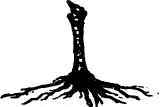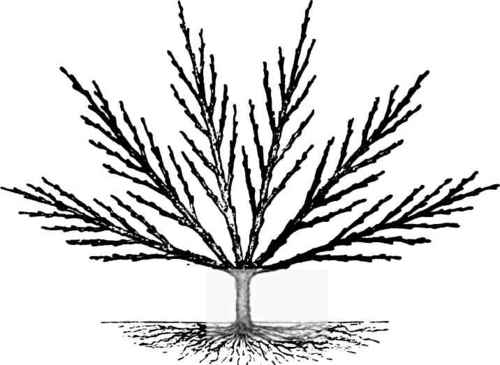The Peach In The North - How To Train It. Part 4
Description
This section is from "The Horticulturist, And Journal Of Rural Art And Rural Taste", by P. Barry, A. J. Downing, J. Jay Smith, Peter B. Mead, F. W. Woodward, Henry T. Williams. Also available from Amazon: Horticulturist and Journal of Rural Art and Rural Taste.
The Peach In The North - How To Train It. Part 4
It will be observed in the past year we had but three branches, which had been headed down in spring to two eyes each; we have, therefore, now six branches, which must be trained at full length with alt the laterals, (or summer shoots;) for the reasons assigned last year, insects must be guarded against, as well as anything that would injure the tree or its foliage; mulching the roots, with occasionally a good watering of liquid manure, will very much assist it; by the end of this (second) summer it will have the appearance of No.

No.2 - headed down the First spring after planting.

No. 3 - As if appears after if first year's growth.

No. 4 - Headed down in spring of second year.

No. 5 - The appearance of the threat the expiration of the second year.
5. Here now we have a tree, healthy, strong, and thrifty, with abundance of roots, a clean stem, well formed, well ripened branches, and capable of being moulded into a beautiful tree in the coming year. Some will perhaps say, our tree is now too thrifty. But this phrase " too thrifty," I do not well comprehend; if by this they mean long, thick, gory, unripened shoots, they may call it "too thrifty" if they please, and they may consider such wood on their trees anything but desirable, but if the system I am describing is properly carried out, the wood will be of a very different character.
In place of spongy, soft unripened snoots, their tissues will be firm, well matured, and as ripe a sun and heat can make them, and under conditions such as these, I say there can be no such thing as " too thrifty." I can well understand in a climate such as England, where the dig .stive and respiratory organs of plants perform their offices slowly, and but too frequently imperfectly, over luxuriant growth is to be guarded against, and wood more moderate in size is desirable, in order to meet the quantity of pure air and elaborated sap. But in the original eastern home of the peach, this will not hold good, nor will it in our own warm sunny climate, which so closely resembles the seasons of its native land. Here revelling in the heat and bright sunshine, the foliage will digest and as similate almost any quantity of sap which is propelled into them, there being nothing to impede their healthy action. I think this may be illustrated in another way; in.cold northern climates, the Laplanders will eat whale blabber, and drink train oil, which to our taste is not very palatable; yet we lire upon strong and nutritious food, when compared to the effeminate Hindoo, who in the warm atmosphere of India, feeds almost exclusively on rice.
This shows that man requires to be fed in accordance with the climate in which he lives, but this is generally acknowledged as regards man and animals, and a little reflection will show it is as strictly true of the vegetable kingdom. I 'said a tree cannot be " too thrifty" if the wood is properly matured, the tree clean and full of health, with abundance of roots in well prepared ground, near the surface. Do persons object to fruit being over large, if the flavor is of as good quality as those of smaller size? I think not. Again florists have rules by which they judge what are termed " florist flowers;" after all the various points are stated, the last comes is size, which is generally worded something in this way, " the larger a flower is, provided it possesses all the other good qualities, the better." Now in what way is this large fruit grown? Has Mr. Mills produced his monstrous pine from little plants? The contrary: his plants, were large, and would indeed be called thrifty. Are the finest grapes grown produced by weak canes? I ' think not. Those who have read Mr. Cuthill's articles on market gardening round London, will judge if the growers of monstrous strawberries, know what it is to have their plants too thrifty.
I might now pass through florist flowers, and show how strength is concentrated in the plants which produce such perfect blooms. But let us glance a little at the animal kingdom. I have yet to learn if the raisers of that beautiful animal, the horse, object to size, if the animal possesses every other good point. Will the breeders of Short-horned and Hereford cattle object to size, combining with it every other good point? Those who raise the fine Leicester sheep, will, I am sure, be pleased with size, combining with it the other qualities. In the same way I may pass through many more, but the above will illustrate my meaning. When, therefore, I hear of " too thrifty," I understand something like the following: A rank luxuriant tree, full of sappy pletltoric shoots, unripened and incapable of being matured, with the roots in an undrained, cold or wet soil. But planted in a proper soil, with good after cultivation, so as to have our wood, as it should be, properly matured, we shall know nothing of "too thrifty." At the close of the second autumn, the trees we said would have the appearance of No. 5, and by this time it is evident we have an amount of strength concentrated in the tree and its roots; the latter will be most numerous, strong, healthy, and active.
The following spring our tree will once more be headed down to two eyes, to a shoot, as shown in No. 6. As we had last year six shoots we shall now have twelve; as soon as these advance in growth, sufficient to receive a tie, they should be secured to the trellis or whatever it is intended they should be trained to; on starting in the past year, I noticed the great amount of care necessary for the preservation of the shoots, lest the symmetry may be destroyed, and more Imperatively necessary is care and vigilance now; the loss of a shoot is now irreparable, and no after skill or judgment can properly supply its place. When the shoots have attained from 15 to 18 inches in length, let the extreme points of all be stopped as shown in No. 7, B. B. This and all subsequent stoppings must be performed on the soft watery points of the shoots; they will then break as freely as though they had not been stopped at all, whereas if the shoots once become firm, they break with more difficulty, and take a longer time.
Continue to:


